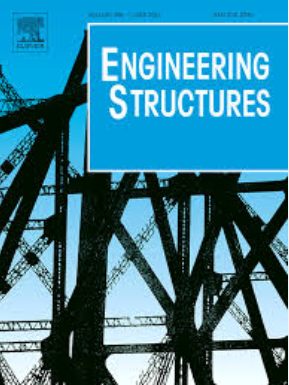Experimental and numerical investigation on ductile fracture behavior of welded areas under tensile and shear forces
IF 5.6
1区 工程技术
Q1 ENGINEERING, CIVIL
引用次数: 0
Abstract
Due to complex stress conditions, welded joints in steel and concrete-filled steel tubular trusses are considered weak parts and are susceptible to failure by fracture. To investigate the ductile fracture behavior of steel tubular welded joints under a combination of tension and shear, this study took 36 specimens from the base/tube metal (BM), heat-affected zone (HAZ) and weld metal (WM) in welded areas. The fracture behavior of five kinds of specimens were compared. Then, to simulate fracture patterns of specimens, this study developed a new Shear-Modified GTN model (SMGTN), which was based on two types of damage variables: tension and shear. The particle swarm optimization (PSO) algorithm was employed to calibrate SMGTN model parameters. Finally, the stress conditions, damage, and fracture patterns of various specimens were analyzed. The result demonstrated that the larger the radius or shear center rotation angle of notched specimens, the larger the fracture displacement. The materials in BM, HAZ, and WM regions exhibited different ductile behavior under different stress conditions. The calibrated parameters of SMGTN model in this study accurately predicted the fracture displacement and development patterns in the BM, HAZ, and WM regions.
求助全文
约1分钟内获得全文
求助全文
来源期刊

Engineering Structures
工程技术-工程:土木
CiteScore
10.20
自引率
14.50%
发文量
1385
审稿时长
67 days
期刊介绍:
Engineering Structures provides a forum for a broad blend of scientific and technical papers to reflect the evolving needs of the structural engineering and structural mechanics communities. Particularly welcome are contributions dealing with applications of structural engineering and mechanics principles in all areas of technology. The journal aspires to a broad and integrated coverage of the effects of dynamic loadings and of the modelling techniques whereby the structural response to these loadings may be computed.
The scope of Engineering Structures encompasses, but is not restricted to, the following areas: infrastructure engineering; earthquake engineering; structure-fluid-soil interaction; wind engineering; fire engineering; blast engineering; structural reliability/stability; life assessment/integrity; structural health monitoring; multi-hazard engineering; structural dynamics; optimization; expert systems; experimental modelling; performance-based design; multiscale analysis; value engineering.
Topics of interest include: tall buildings; innovative structures; environmentally responsive structures; bridges; stadiums; commercial and public buildings; transmission towers; television and telecommunication masts; foldable structures; cooling towers; plates and shells; suspension structures; protective structures; smart structures; nuclear reactors; dams; pressure vessels; pipelines; tunnels.
Engineering Structures also publishes review articles, short communications and discussions, book reviews, and a diary on international events related to any aspect of structural engineering.
 求助内容:
求助内容: 应助结果提醒方式:
应助结果提醒方式:


